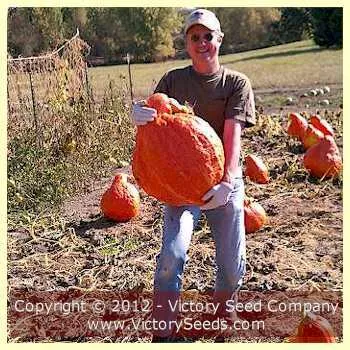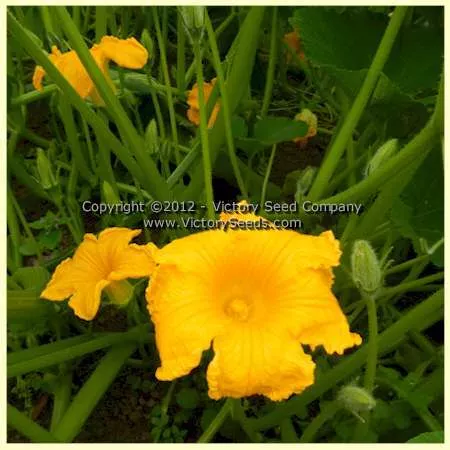










Boston Marrow Squash
Price: $4.45
SKU: 3370341Early mentions of 'Boston Marrow' describe it as weighing from five to six pounds. By the mid-1930s, its size had been increased to what we now see today.[3] The fruit have reddish-orange skin and measure about twelve inches in diameter by about sixteen inches in length. Weighing from eleven to over fifty-two pounds each, they average about twenty-five pounds. The flesh is fine-grained, yellow-orange, and bakes to a bright orange color. The leading seedsmen of the late 19th Century referred to 'Boston Marrow' as the "true pie squash," and seemed to prefer it over the drier varieties. It can be used as a table squash as well as for pie filling.
Even though it is a large-fruited variety, it is very productive. We kept careful statistics for our 2012 season. In a patch that measured ten feet by forty feet, containing six hills of plants, we harvested twenty-seven squash. Their weights ranged from 12 to 52.5 pounds with an average of 25.6 pounds. The total harvested from that one patch was 639 pounds!
In a letter published by Fearing Burr, Jr., Mr. John M. Ives of Salem, Massachusetts acknowledged the gift of a specimen in the Spring of 1831 from a friend in Northampton, Massachusetts, who in turn had received the seeds from Buffalo, New York. He described that the original seed had been furnished to Buffalo gardeners by a tribe of Indians who visited that area in the spring of each year.[1,3] And this is where the historic documentary trail ends.
Skeptical, James J. H. Gregory wrote in the New England Farmer, "If this squash originated among our Indians as this statement might lead us to infer, it is too much to suppose that with its splendid appearance and the many excellent qualities it possessed when first introduced, it should have been unknown to the whites to so late a day."
An heirloom to the Buffalo, New York area, it was first distributed to select members of the Massachusetts Horticultural Society by Mr. Ives in the Spring of 1833[2] and quickly became available as a commercial variety shortly thereafter.
Genetic Classification: Open Pollinated
- "Field and Garden Vegetables of America," Fearing Burr, 1863, p. 202.
- "New England Farmer," John. M. Ives, Jan., 1859, Vol. 11, Page 52.
- "Vegetables of New York: The Cucurbits," New York Agricultural Experiment Station, 1935, p. 18.
Other synonyms include; Autumnal Boston Marrow, Autumnal Marrow, Boston Vegetable Marrow, Cambridge Marrow, Chicago Marrow, Chicago Orange Marrow, Colvin's Orange Marrow, Dunlap Early Prolific Marrow, Early Marrow, Early Orange Marrow, Early Prolific Marrow, Early Prolific Orange Marrow, Extra Early Marrow, Extra Early Orange Marrow, Extra Early Prolific Marrow, Extra Early Prolific Orange Marrow, Golden West Hard Shell, Improved Boston Marrow, Improved Marrow, Improved Orange Marrow, Improved Prolific Marrow, Improved Prolific Orange Marrow, Large Boston Marrow, Marrow, Metcalf, Orange, Orange Marrow, Prolific Marrow, Prolific Orange Marrow.[3]
Customer Reviews:
By Wind Chapman (Dahlonega, GA) on January 31, 2025
The is the finest eating pumpkin there is. I know it's sold as a squash and it grows on a hollow vine like a summer squash, but for eating, it is a pumpkin; the best tasting you will ever find. The skin is thin so it is not suited for commercial use, but it's perfect for home use and storage.
By Neil Moffett on January 31, 2020
We grew these as part of a Three Sisters garden. The squash are enormous; several were two feet long. These were eaten less by the deer than were all other squash varieties except kabocha. We used these for pie as well as in place of sweet potato casserole; the flavor was outstanding. The seeds roast well and are indistinguishable from roasted pumpkin seeds. As long as the skin is unblemished these have proven to be good for storage, lasting far longer than sweet pumpkins and some almost as long as kabocha.
By David Emigh on December 1, 2013
Near perfect germ, no pest trouble, almost no disease problems: very late in the season they did develop a bit of Downy on the older leaves, but this was not a critical problem. Got mine in a bit late, but they made up for lost time! The vines never did stop blooming and setting, and very quickly over-ran their plot, adjacent plots, and the yard. Due to late start, my fruits were only in the 25-30 lb range, and PROLIFIC. Sweet, very fine grained flesh, seed cavity a bit large and well stuffed (but I like the seeds too). Flavor is incomparable, so I won't try. These bad boys will be in my garden (well, corn patch from now on, I think) for as long as I am.















